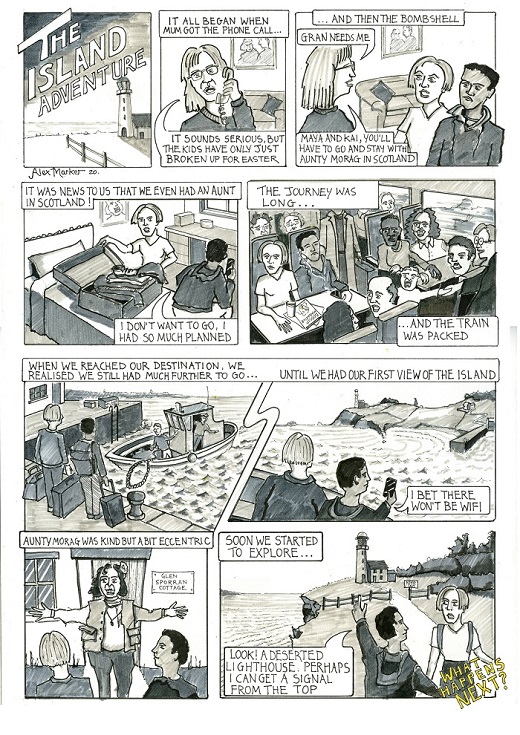Creating a Comic Strip
The Island Adventure
by Alex Marker and ...you!

What do the children find on the Island?
What is in the Abandoned Lighthouse?
Why has Mum never told the children about Aunt Morag and the Island before?
Why is Gran in trouble?
Will Kai ever manage connectivity?
With your permission, we will post some of your stories on The Questors social media sites. Please send your completed stories to marketing@questors.org.uk. To download and print the comic strip and continuation pages, please click HERE.
Some tips
1. I have drawn out a blank sheet of panels which you can use for page 2 if you wish, or you can create your own format. Playing with the size and number of panels can give your comic a very different feel.
2. I like working on A3 paper, as I find drawing a whole page on A4 far too small. If you don’t have access to an A3 printer/scanner make sure there is a break in the artwork half way down the page, then you can print/scan the page in as two landscape A4 sheets. We can stick them back together again at our end (N.B. make sure you number the sheets!)
3. Create a rough first, where you decide what needs to go in each panel. I write the dialogue at this stage so I don’t run into the problem where I run out of space for the words.
4. Do some research to help you get the backgrounds right. I had to find a picture of a fishing boat for panel 6, as I’ve never needed to draw one of these before! If I was drawing a second page I would certainly need to find some pictures of lighthouse interiors.
Drawing Style
There are a huge range of drawing styles out there - you need to find one that works for you. Marvel comics have a very different line style to, say, The Beano; and the style of Hergé’s Tintin adventures is a world away from Manga comic art. You don’t have to copy my style… Unless you want to!
What’s this got to do with drama, I hear you say?
At heart this is a narrative building exercise. It’s about creating and telling your story in an economical way. You have to decide the following when planning your panels: Does this advance the action of the story? Does it develop the character? Does it help to create the world they inhabit? Ideally a single panel can do more than one of these at the same time.
Hergé’s Tintin adventures were originally serialised in newspapers, a line of panels at a time. This means that each strip of frames comprises one mini story beat, culminating in a ‘what happens next?’ style page turner at the bottom of the page.
Good Luck!
Alex




